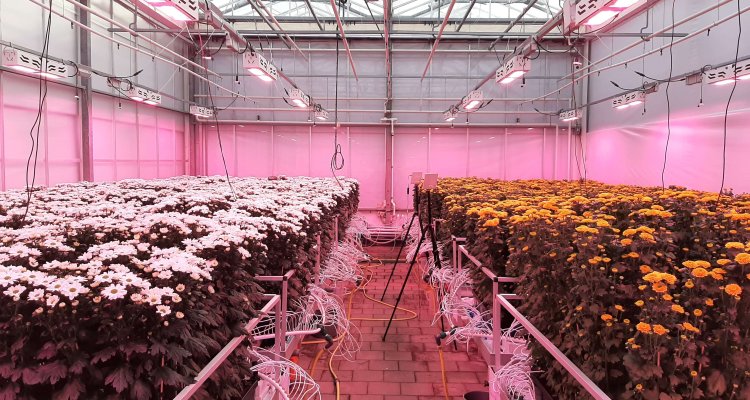
News
Controlling chrysanthemum cultivation based on sensor information
Chrysanthemum cultivation faces a number of challenges in the coming years: reducing energy consumption for steaming soil, reducing nutrient emissions, and controlling cultivation based on plant measurements. These challenges formed the basis of a trial at Wageningen University & Research's Greenhouse Horticulture business unit, where chrysanthemums were grown in containers with a soil mixture.
"We grew two chrysanthemum varieties with two irrigation strategies. In one strategy we watered by default ("sufficient irrigation") in the other only 75% of that amount per turn ("limited irrigation"). Growers show a lot of interest in water uptake by the crop in chrysanthemum cultivation. To monitor this properly, we used a number of plant and substrate sensors during cultivation for continuous and automated measurements of plant weight, plant temperature, water uptake and drain,' explains Anja Dieleman, senior researcher in plant physiology at WUR Glasshouse horticulture.
Soil water content sensors proved to be very effective in controlling the irrigation strategy. Thanks to these sensors, soil moisture content was kept constant during cultivation in both strategies. Drain rates were about 15% in the "sufficient irrigation" treatment, and there was almost no drain in the "limited irrigation" treatment.
Crop evaporation was calculated from plant temperature measurements and climate data. Evaporation showed a clear trend over the day, related to irradiance. Calculated evaporation corresponded well with plant weight measurements and they showed a clear difference in transpiration between watering strategies. The treatments did not affect stem length and shoot weight of the harvested chrysanthemum flowers. Dieleman: "This indicates that we can reduce irrigation rates without negative effects on the crop and that control via crop and substrate sensors shows perspective, which means we have taken next steps towards autonomous chrysanthemum cultivation."